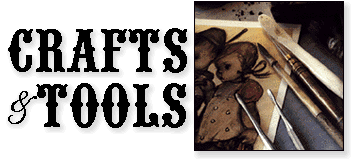
The right tool for the job! ...but what's the job?

The best advice your grandfather ever gave you was "always use the right tool for the job." Having seen someone attempt to use a monkey wrench to drive a 16d nail into wood paneling to hang a picture, I can appreciate this wisdom.On this page, we present descriptions of crafts and the tools used divided into two categories:
and
(Click and Go)Reading these lists, you might get ideas of some crafts you may wish to try (and new toys to buy yourself). Where possible, we provide pictures of the craft or tool.


candlewicking
- a form of embroidery using a single ply of string for floss on a coarser fabric canvas. The main stitches are the outline (or backstitch) and the French knot. Uses standard hoops or frames, a heavier needle, standard scissors.
crewel
- a form of embroidery using light yarns for floss on a heavy fabric or broadcloth canvas. Bee's wax is applied to the yarn end to assist in threading the needle. Stitches and equipment are otherwise standard to embroidery (see History of Crewel, by Anny).
cross-stitch
- A form of embroidery by forming x's. May be counted or non-counted. Counted cross-stitch is done by the thread count in the fabric embroidered on. Special canvases with 14, 18, and 24 thread counts are a favorite medium (the brand name Aida Cloth). Counted stitch also may be done using a special web fabric called Tear-Away which is removed once the embroidery is finished by wetting it and pulling web strands out with tweezers. Non-counted cross-stitch usually comes on pre-printed linens or as iron-on patterns.
papier mache'
- a sculpting medium produced by saturating strips or bits of paper with a gluttonous substance and applying them to a form. Generally speaking, the finer the strips or the finer or more porous the paper, the smoother the end product and the longer the drying time. When dried, the resulting material is generally stiff and readily accepts paint and other applications.
rug hooking
- canvas is a somewhat wide and very stiff net. Rug yarn or a standard yarn is cut into lengths depending on the height of the rug desired (end product is 1/2 the length minus loop). A latch hook is used to create a loop through and around the warp of the canvas generally in the same direction. Color patterns are generally employed to create pictures, messages, or abstract designs. Variations in yarn length, use of the weft to pack more tightly, and direction of yarn can be used to enhance the pattern.

hammer
- A lightweight hammer is a practical necessity for every household. Even if you only use it to hang an occassional picture, it is a tool invaluable.
marking tools
- Minimally, a pencil is necessary at hand near every craft project. Chalk, chalk pencils, grease markers, felt pens, etc. are all good marking tools although many have use limitations particularly where it comes to removing or covering the mark later.
measuring tapes
- Cloth or metal measuring tapes are a necessity for every crafter. In sewing, you want a cloth or flexible plastic tape for measuring body dimensions, etc.; for other projects, a stiffer metal tape measure which retracts is a definite must.
power screwdriver
- A must tool in every household, a rechargable power screwdriver may be used to drill or drive screws. Attachments make it possible to use for small sockets, drilling counter-sink holes, and drilling or driving screws around corners or small areas.
scissors
- A must for every household. If you work in needle crafts, you know that you must have one pair set aside for your use in cutting fabric and thread only and another pair for household use as cutting paper and other materials tends to dull the scissors.
utility knife
- Another item every home should have. With a good utility knife you can cut linoleum tile or open bags of potting soil and fertilizer. A good knife, however, is also a safe knife and the better utility knives have retractable blades (the button on top in the picture below slides the blade in and out). The screw in the handle of most utility knives opens to a compartment where spare blades are stored which can be changed very easily, but you may also reverse the current blade for longer usage.

exclusively for The Yahoo! Crafter's Place Chat Club
on 08/01/99.
You are visitor # since this page was created.
It is best viewed on a 800x600 screen set for True Color
with  or
or  and
and
is hosted by  . Get them NOW!
. Get them NOW!


